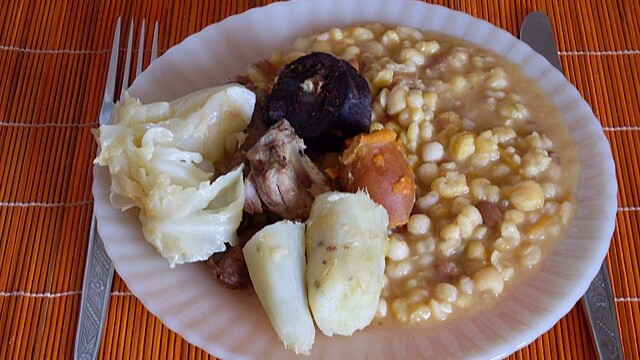On the windswept archipelago of Cabo Verde, the sea’s rhythm shapes daily life, but it is at the table that the islands’ history and identity most vividly emerge. Stretching across ten volcanic islands in the Atlantic, this nation’s cuisine carries the imprint of African roots, Portuguese colonial ties, and Brazilian influences—woven together through centuries of trade, migration, and adaptation. The result is a culinary tradition as layered as the islands themselves, at once humble and celebratory.
Cachupa: A Stew of Memory and Resilience
At the heart of the national palate lies cachupa, a slow-simmered stew long considered the soul of Cape Verdean cooking. Built on hominy corn and beans, it takes many forms: cachupa rica, richer with pork, sausage, and sometimes chicken; and cachupa pobre, a simpler, often meatless version, rooted in subsistence cooking.
Its preparation demands patience—ingredients soaked overnight, flavors melding over hours. Leftovers find a second life as cachupa refogada, reheated in a skillet with onions and oil, sometimes topped with a fried egg and served alongside coffee. In its versatility and enduring presence, cachupa is both sustenance and social bond.
Pastel com Diabo Dentro: Spice in a Pastry
Street vendors in Mindelo and Praia often serve pastel com diabo dentro, “pastry with the devil inside.” The name nods to its heat: a crisp, golden shell enclosing tuna, onions, and peppers in a fiery blend. Best eaten fresh from the fryer, it is a snack that pairs naturally with a cold beer or a measure of local grogue.
Lagostada: Lobster in Rich Broth
From the surrounding Atlantic come dishes that showcase abundance from the sea. Lagostada is among the most indulgent—a lobster stew cooked with tomatoes, onions, garlic, and sometimes coconut milk. Served over rice or potatoes, it captures both the opulence of a celebratory feast and the straightforward comfort of a coastal meal.
Caldo de Peixe: A Fisherman’s Soup
In fishing villages, caldo de peixe is a mainstay. Whole local fish are simmered with onions, tomatoes, and root vegetables such as sweet potato and yam, producing a broth with a clean yet deeply briny character. Cornmeal dumplings, called xerém, often accompany the soup, though crusty bread serves just as well.
Buzios: Conch with Coastal Character
Another emblem of maritime resourcefulness is buzios, or conch stew. The meat, tender yet substantial, is simmered with onions, garlic, peppers, and tomatoes. Common along the coasts where conch is plentiful, the dish is usually served with rice or potatoes, its sauce lending depth to simple starches.
Grogue: The Spirit of the Islands
No account of Cape Verdean food is complete without grogue, the traditional sugarcane spirit distilled in small batches across the islands. Stronger and more rustic than most rums, it is often consumed neat, though it also serves as the base for ponche, a sweeter, citrus-scented drink made with honey and spices. In either form, it remains both a social lubricant and a cultural touchstone.
A Sweet Ending
Cape Verdean desserts tend toward simplicity. Pudim de queijo, a dense cheese pudding, blends richness and sweetness in a single bite. Bolachas de mel—honey cookies—offer a warm, spiced aroma, while cuscuz, a steamed cornmeal cake sometimes sweetened with coconut, speaks to the islands’ African heritage.
The Islands on a Plate
Taken together, these dishes form more than a menu—they are a record of adaptation and exchange, of landscapes shaped by drought and ocean bounty, and of a people who have preserved their culinary traditions while welcoming new influences. In every bowl, pastry, and glass, the flavors of Cabo Verde carry both the resilience of its history and the warmth of its hospitality.
Sources:
- Lobban, Richard A. Cape Verde: Crioulo Colony to Independent Nation. Westview Press, 1995.
- Davidson, Alan. The Oxford Companion to Food. Oxford University Press, 2014.
- Fernandes, Gabriel. “Cuisine and Cultural Identity in Cape Verde.” African Arts, vol. 40, no. 3, Autumn 2007.

